BEEF’s survey reveals that most readers are happy with the services their veterinarians provide.Download the complete survey results here.

With increasing intensity, beef producers and food animal veterinarians are under scrutiny. Driven by cultural and societal changes, those who consume the food that ranches and farms produce are demanding more — more transparency, more explanation of how and why you do what you do, and more involvement in the decision-making process behind ag production practices.
And, in some cases, they’re demanding less — less of the animal health products and technologies that help you produce the safest, most wholesome beef in the world.
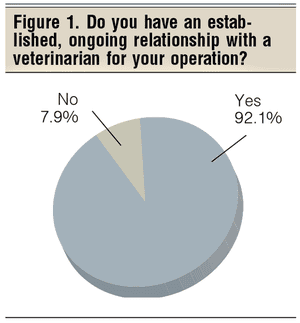 In this changing and dynamic environment, how beef producers interact with their veterinarians will become increasingly important — not just in assuring consumers that the animals that produce the beef they eat are treated humanely and appropriately, but in dealing with growing regulatory pressure on the availability and use of animal health products, production practices and technologies.
In this changing and dynamic environment, how beef producers interact with their veterinarians will become increasingly important — not just in assuring consumers that the animals that produce the beef they eat are treated humanely and appropriately, but in dealing with growing regulatory pressure on the availability and use of animal health products, production practices and technologies.
That was the basis of BEEF magazine’s latest survey of readers, which drilled into how you interact and use your veterinarian. Based on the survey results, the vast majority of beef producers have an established, ongoing and positive relationship with a veterinarian. In fact, 92% of respondents indicate that their veterinarian is no stranger (Figure 1).
Good relationships
What’s more, the majority of respondents indicate they have a longtime relationship with their veterinarian, with 56.1% saying their veterinarian has provided care for their operation for 10 years or more. Additionally, 2.3% report they have used the same vet for six to 10 years and 19.1% say their relationship has been ongoing for two to six years. Just 4.4% indicate that their vet is new to their operation, providing care for a year or less (Figure 2).

Having an established relationship with your vet can be important for several reasons. Of those who say they do not have an ongoing relationship with a veterinarian, 13.3% say they nearly always or always have trouble obtaining emergency veterinary services. An additional 26.7% say they usually have difficulty getting emergency help, for a total of 40% of respondents without a veterinary relationship who say emergency veterinary services can be a challenge. Those who seldom have trouble getting emergency services total 37.3% of respondents, and 22.7% say they never have a problem getting veterinary help when needed (Figure 3).
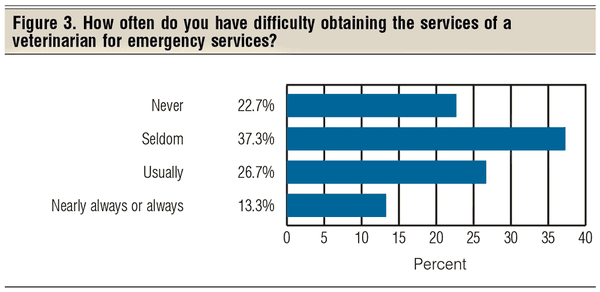
Otherwise, for routine veterinary services, most respondents say they see their vet several times a year — 36.5% say their vet visits their operation three to five times a year, and 32.9% say the vet stops by one or two times a year. And a few use their vet heavily — 10.2% say they see the vet six to nine times a year, and 9.3% say the vet is on the place 10 or more times a year. However, 11.2% say they never have a veterinarian on-site at their operation (Figure 4).
BEEF asked a question that may generate a different answer if posed to veterinarians than when asked of their clients. But when BEEF readers were asked how their veterinarian would rate their operation for ease, comfort and safety of the veterinary work performed there, 57% say they are better than average, and 16.9% think their operation is outstanding. About a fourth (24.6%) say their facilities are adequate, and 1.5% admit that what they have for the vet to work with is poor (Figure 5).
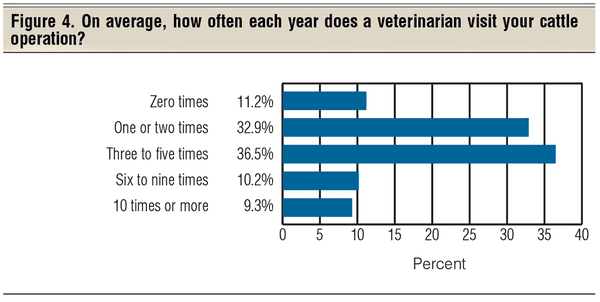

Those who have an ongoing relationship with a veterinarian are generally pleased with the arrangement, with 69% saying they are very satisfied with the services their veterinarian provides. Additionally, 15.3% are somewhat satisfied and 13% are satisfied with their vet. Only 2.7% report that they are not satisfied with the services their vet offers (Figure 6).
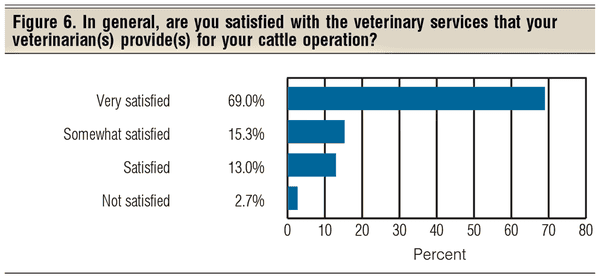
Veterinary services
And what services do beef producers value most? When asked what services they paid a veterinarian to provide in the last 12 months, 75.9% listed emergency treatment as No. 1. Beyond that, 67.9% indicate that disease treatment and overall herd health management is important, followed by pregnancy testing at 65.5%; bull soundness exams at 61.7%; and health tests for cattle marketed or purchased at 30%. (Figure 7). Totals add up to more than 100% because of multiple answers.
Of the services beef producers asked their veterinarian to perform in the last year, most are ongoing practices. Only 12.1% indicate that they asked their veterinarian to do additional work in the last year, with 87.9% saying their veterinarian provides the same services as always.
Of those who asked their veterinarian to add new services in the past year, cow and heifer synchronization and artificial insemination tied with disease prevention and overall herd health management at the top of the list, with a 17.8% response for each. Heifer development followed closely behind at 16.8%, as did bull soundness exams at 12.1%, facility design and modification at 11.2% and health tests at 10.3% (Figure 8).
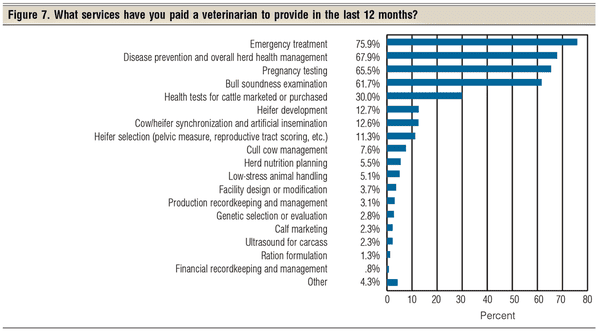
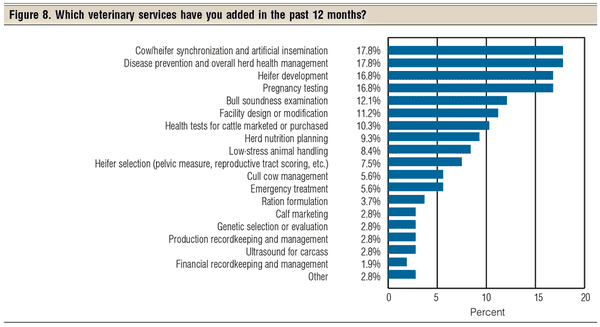
When asked what additional services they’d like their veterinarian to offer beyond what is currently available, 17.9% of respondents say they would like to ultrasound their cattle to determine carcass potential. That was followed by disease prevention and overall herd health management at 14.3%; herd nutrition planning at 14%; heifer selection, including pelvic measurements and reproductive tract scoring, at 13.1%; synchronization and AI at 12.2%; genetic selection, such as help in understanding and using expected progeny differences (EPD), at 12.2%; and facility design and modification at 10.7%. Additional responses include performing bull soundness exams at 10.4%, ration formulation at 10.4% and emergency treatment at 10.1% (Figure 9).
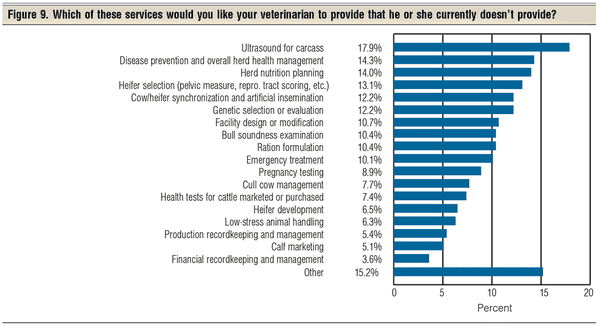
Biosecurity?
Biosecurity may be an area where cattle producers can include their veterinarian’s help in improving their operations. When asked if they have worked with their veterinarian in developing a biosecurity plan for their operation, only 12.1% of respondents say yes. A whopping 87.9% of respondents indicate they have not worked with their vet in developing a plan to keep disease organisms at bay (Figure 10).
| Download the complete survey results in .PDF format |
However, when asked how prepared veterinarians in their community are to respond to a serious foreign animal-disease outbreak or an act of bioterrorism against livestock, 39.6% say they have no idea. However, 40.4% think their local veterinarians are ready for the challenge while 15.8% think their community is inadequately prepared to deal with a serious problem, and 4.2% say they are not prepared at all (Figure 11).
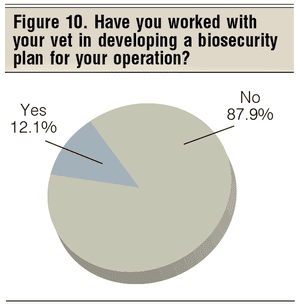
According to Scott Grau, Penton Agriculture’s senior research manager, the survey results tell several tales. He’s not surprised that many cattle producers who responded to the survey have a long-term relationship with their veterinarians. “This makes sense, since there isn’t a high rate of turnover of cattlemen, and there is a limited supply of veterinarians willing to work with large animals,” he says. But as regulatory pressure ratchets up, such as the recently announced veterinary feed directive, producers will find that established relationship will work to their advantage.
However, Grau says the survey results point out a potential management opportunity. “Three-quarters of respondents use a vet for emergency services, and the frequency of the vet visiting an operation is less than five times per year. If you need the vet for emergency services more than a few times a year, you’ve got some problems that need to be addressed.”
Grau also notes a mathematical improbability. A total of 75% of our respondents feel their facilities for working cattle are outstanding or better than average. “I think many operators don’t work their cattle too frequently because they don’t have to, so they are willing to accept the little shortfalls in their facilities,” he says.

On the other hand, however, he notes that BEEF readers are all full-time cattle producers who are willing to invest in facilities and make improvements to better handle cattle in a more safe and efficient manner — so perhaps the survey results aren’t that far off.
All in all, the survey shows that the majority of cattle producers have the veterinary relationship they need to ensure herd health management. As time goes on and more pressure comes to play in the use of animal health products, that relationship will be essential.
You might also like:
15 photos showcase hardworking American ranchers
Genetic accident produces White Angus
What's the best time to castrate calves? Vets agree the earlier the better
About the Author(s)
You May Also Like




